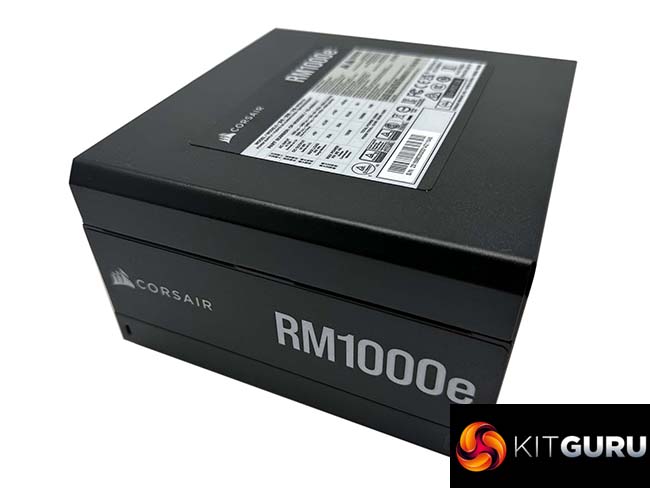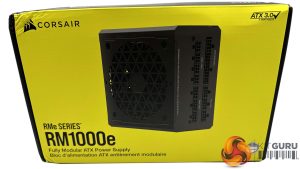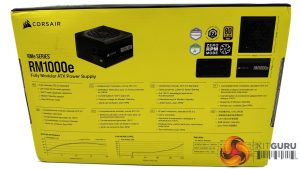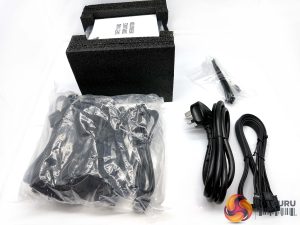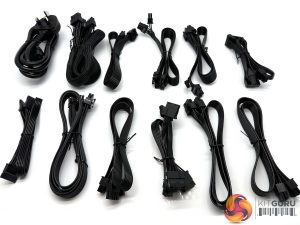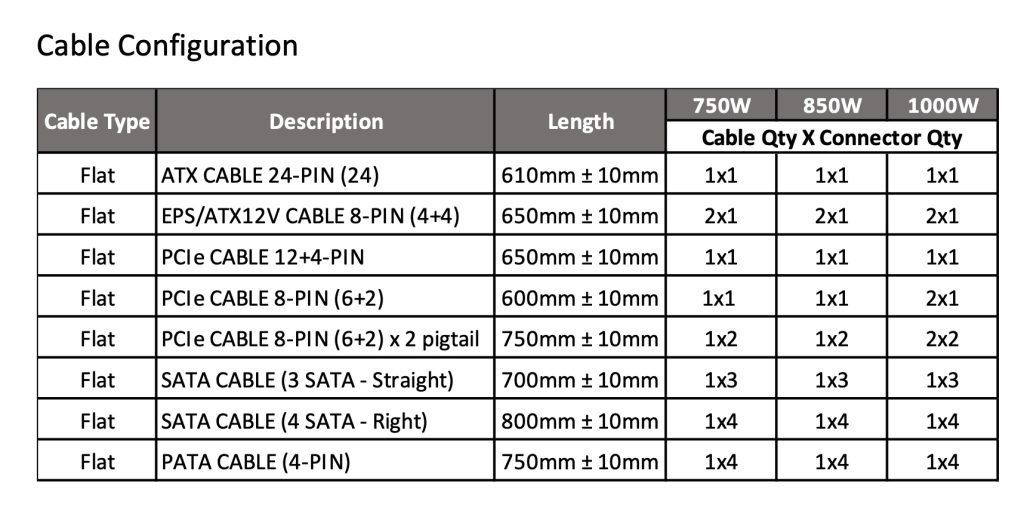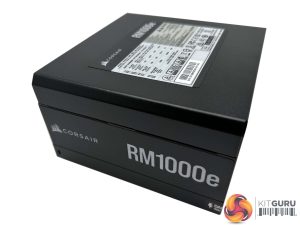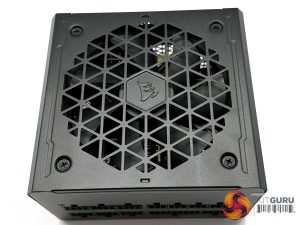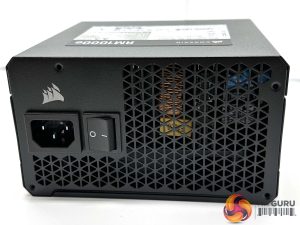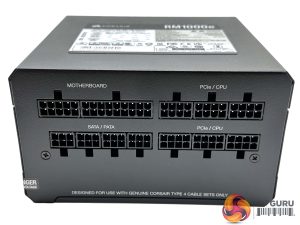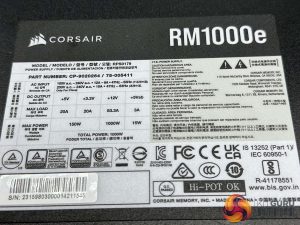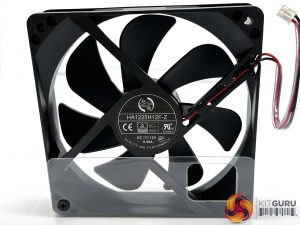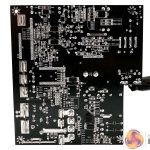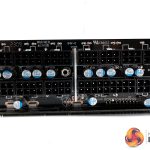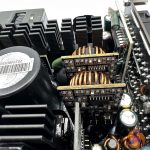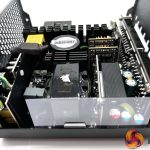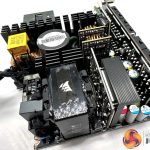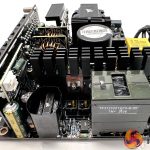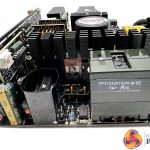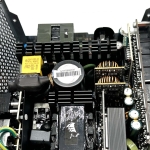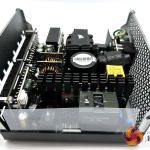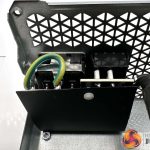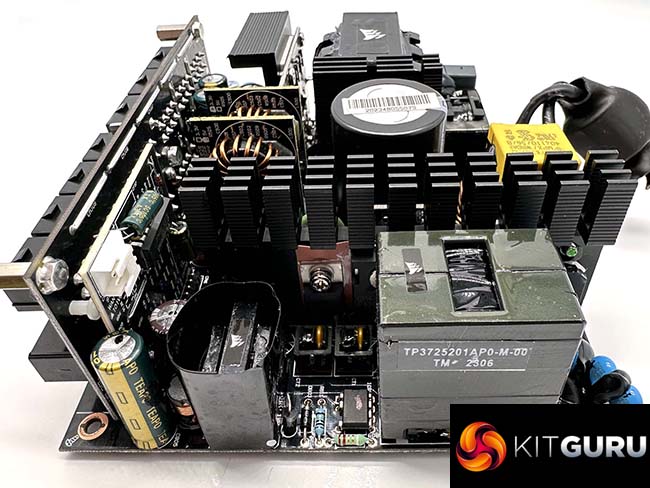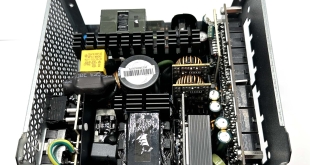
Corsair recently sent us a couple of new power supplies for analysis. Today we look at the latest RM1000e unit which is a fully modular, 80 Plus Gold certified supply at a very competitive price point around £170 inc VAT. This new 2023 unit offers ATX 3.0 certification and is PCIe 5.0 ready.
We always recommend our readers to aim for at least 80 Plus Gold Efficiency when considering a new power supply. This particular unit is said to ship with 105C rated capacitors, deliver excellent electrical performance and has the backing of a seven year warranty. While we have no confirmed UK price from Corsair, Amazon UK are already stocking the new 2023 model for £167.95 HERE. (Do be careful, Amazon are still stocking the older 2022 model as well).
Additionally, many people will find this unit appealing as it is a relatively compact 14cm length suited to installation inside a massive cross section of case designs and sizes.
- Fully Modular PSU: Reliable and efficient low-noise power supply with fully modular cabling, so you only have to connect the cables your system build needs.
- Intel® ATX 3.0 Certified: Compliant with the ATX 3.0 power standard, supporting the PCIe Gen 5 platform and resisting transient power spikes.
- Keeps Quiet: A 120mm rifle bearing fan with a specially calculated fan curve keeps fan noise down, even when operating at full load.
- 105°C-Rated Capacitors: Delivers steady, reliable power and dependable electrical performance.
- Modern Standby Compatible: Extremely fast wake-from-sleep times and better low-load efficiency.
- 80 PLUS Gold-Certified: Steady power output at up to 90% efficiency, and Cybenetics Platinum certified for lower power consumption, less noise, and cooler temperatures.
- Zero RPM Fan Mode: For near-silent operation at lower loads.
- The Right Fit: Compact 140mm-long casing ensures an easy fit in modern enthusiast PC cases.
- Resonant LLC Topology with DC-to-DC Conversion: Provides clean, consistent power and enables use of more energy-efficient sleep states.
- Seven-Year Warranty: Your guarantee of reliable operation for peace of mind through multiple builds.
Corsair have opted for their traditional bright yellow box artwork with an image of the unit on the front.
The rear of the box highlights some key features, including the zero RPM mode, low noise characteristics.
The majority of the supplied cables are flat ribbon style for ease of routing during the build phase. Corsair also supply cable ties, a regional specific power cable and screws for mounting. The 24-pin main power supply cable is braided as shown in the images above.
As expected, the cables supplied with the 1000W unit should cover any building requirements for the majority of users, including a PCIe 5.0/12VHPWR connector. The cables are long enough for even the biggest cases available on the market today.
The Corsair RM1000e 2023 chassis is colour neutral and suited for any system themed build you might have in mind.
A large fan sits behind a grill on the top of the chassis. We will take a closer look at the fan when we open the chassis shortly.
One side of the chassis is home to the power switch, power socket and vents to aid air flow and cooling. On the other side is the modular bay – these are all clearly labelled for ease of use during the building phase. The joys of having a fully modular power supply is that only the cables you need to use can be connected.
The +12V can deliver 83.3 Amps via the single rail configuration, and 20A on both +3.3V and +5V rails.
Corsair are using a Hong Hua fan. Model HA1225H12F-Z DC12V, 0.58A specification. This is a fluid dynamic bearing (FDB) hydrodynamic bearing fan which should be relatively quiet based on previous experience in testing. The maximum volume is set to 2,300 rpm with an airflow of around 67.3CFM.
This unit is an active PFC + half bridge LLC resonance and synchronous rectification + DC-DC design. The design implements independent PCBs for the DC-DC modules and synchronous rectification. The level one EMI adopts independent PCB design. This is equipped with a pair of Y capacitors and two X capacitors with a common mode inductor. The primary PCB contents the second level EMI circuit including a common mode inductor and a single X capacitor and a pair of Y capacitors. An MOV and NTC are also present. An independent relay is seen between the primary cap and the PFC circuit.
The primary stage has a single Taiwanese 105c rated Elite Jinshan cap. These caps are pretty good, even if they fall a bit short of the highest grade caps from Japanese brands such as Nippon Chemi Con or Rubycon.
The modular bay is home to a plethora of solid capacitors for output filtering. The unit also has OVP, OCP, SCP, OPP and OTP protections in place.
Correctly testing power supplies is a complex procedure and KitGuru have configured a test bench which can deliver up to a 2,000 watt DC load.
We test ambient temperatures at 35c in our environment to greater reflect warmer internal chassis conditions.
We use combinations of the following hardware:
• SunMoon SM-268
• CSI3710A Programmable DC load (+3.3V and +5V outputs)
• CSI3711A Programmable DC load (+12V1, +12V2, +12V3, and +12V4)
• Extech Power Analyzer
• Extech MultiMaster MM570 digital multimeter
• SkyTronic DSL 2 Digital Sound Level Meter (6-130dBa)
• Digital oscilloscope (20M S/s with 12 Bit ADC)
• Variable Autotransformer, 1.4 KVA
We test in a single +12V configuration.
|
DC Output Load Regulation
|
||||||||||
|
Combined DC Load |
+3.3V
|
+5V
|
+12V
|
+5VSB
|
-12V | |||||
|
A
|
V
|
A
|
V
|
A
|
V
|
A
|
V
|
A | V | |
|
100W
|
0.90
|
3.32
|
0.90
|
5.01
|
7.35
|
12.12
|
0.50
|
5.01
|
0.20
|
-12.01
|
|
200W
|
1.60
|
3.32
|
1.64
|
5.01
|
15.13
|
12.12
|
1.00
|
5.01
|
0.20
|
-12.01
|
|
500W
|
3.20
|
3.32
|
3.25
|
5.01
|
38.60
|
12.10
|
1.50
|
5.01
|
0.20
|
-12.01
|
| 750W |
4.03
|
3.32
|
4.16
|
5.00
|
58.53
|
12.06
|
2.00
|
5.01
|
0.30
|
-12.01
|
|
1000W
|
5.45
|
3.32
|
5.51
|
5.00
|
78.13
|
12.02
|
2.50
|
5.01
|
0.30
|
-12.01
|
The load regulation of this power supply is solid throughout, with only minor dip on the +12V rail.
| Corsair RM1000e | Maximum Load |
| 1123W |
The power supply managed to deliver 1123W before shutting down safely.
Next we want to try Cross Loading. This basically means loads which are not balanced. If a PC for instance needs 500W on the +12V outputs but something like 30W via the combined 3.3V and +5V outputs then the voltage regulation can fluctuate badly.
| Cross Load Testing | +3.3V | +5V | +12V | -12V | +5VSB | |||||
| A | V | A | V | A | V | A | V | A | V | |
| 885W | 2.0 | 3.32 | 2.0 | 5.01 | 72.0 | 12.02 | 0.2 | -12.01 | 0.50 | 5.01 |
| 240W | 20.0 | 3.30 | 23.0 | 4.97 | 2.0 | 12.12 | 0.2 | -12.01 | 0.50 | 5.01 |
The Corsair RM1000e handled our cross load test very well, holding stable results across the range.
We then used an oscilloscope to measure AC ripple and noise present on the DC outputs. We set the oscilloscope time base to check for AC ripple at both high and low ends of the spectrum. ATX12V V2.2 specification for DC output ripple and noise is defined in the ATX 12V power supply design guide.
|
ATX12V Ver 2.2 Noise/Ripple Tolerance
|
|
|
Output
|
Ripple (mV p-p)
|
|
+3.3V
|
50
|
|
+5V
|
50
|
|
+12V1
|
120
|
|
+12V2
|
120
|
|
-12V
|
120
|
|
+5VSB
|
50
|
Obviously when measuring AC noise and ripple on the DC outputs, the cleaner (less recorded) means we have a better end result. We measured this AC signal amplitude to see how closely the unit complied with the ATX standard.
| AC Ripple (mV p-p) | ||||
| DC Load | +3.3V | +5V | +12V | 5VSB |
| 100W | 10 | 5 | 10 | 5 |
| 250W | 10 | 5 | 10 | 10 |
| 500W | 15 | 10 | 20 | 10 |
| 750W | 20 | 15 | 25 | 15 |
| 1000W | 25 | 15 | 35 | 15 |
Ripple noise suppression is pretty good and well within industry rated parameters. At full load the +3.3V and +5V rails peak at 25mV and 15mV respectively. The +12V rail peaks at 35mV.
|
Efficiency (%)
|
|
|
100W
|
88.7
|
|
250W
|
90.3
|
|
500W
|
92.6
|
|
750W
|
91.7
|
|
1000W
|
89.6
|
The efficiency results are excellent, peaking at 92.6% at close to 55% load. This drops to just under 90% efficiency at full load. These are really very positive results for an 80 Plus Gold rated unit.
We take the issue of noise very seriously at KitGuru and this is why we have built a special home brew system as a reference point when we test noise levels of various components. Why do this? Well this means we can eliminate secondary noise pollution in the test room and concentrate on components we are testing. It also brings us slightly closer to industry standards, such as DIN 45635.
Today to test the Power Supply we have taken it into our acoustics room environment and have set our SkyTronic DSL 2 Digital Sound Level Meter (6-130dBa) one meter away from the unit. We have no other fans running so we can effectively measure just the noise from the unit itself.
As this can be a little confusing for people, here are various dBa ratings in with real world situations to help describe the various levels.
KitGuru noise guide
10dBA – Normal Breathing/Rustling Leaves
20-25dBA – Whisper
30dBA – High Quality Computer fan
40dBA – A Bubbling Brook, or a Refrigerator
50dBA – Normal Conversation
60dBA – Laughter
70dBA – Vacuum Cleaner or Hairdryer
80dBA – City Traffic or a Garbage Disposal
90dBA – Motorcycle or Lawnmower
100dBA – MP3 Player at maximum output
110dBA – Orchestra
120dBA – Front row rock concert/Jet Engine
130dBA – Threshold of Pain
140dBA – Military Jet takeoff/Gunshot (close range)
160dBA – Instant Perforation of eardrum
|
Noise (dBA)
|
|
|
100W
|
<28.0
|
|
250W
|
<28.0
|
|
500W
|
30.4
|
|
750W
|
31.6
|
| 1000W | 35.7 |
The large fan does not start to spin until around 500 watts load, and then it was inaudible in our environment.
Once we hit around 900 watts load, the fan started to actively ramp up to deal with rising temperatures inside the chassis. At full load, the fan was clearly audible, but if you are running a system at 1000 watt load regularly, you really need to be thinking about a unit more in the 1500 watt power range. This would help achieve much more tolerable noise levels and hit much more optimal levels of efficiency.
|
Temperature (c)
|
||
|
Intake
|
Exhaust
|
|
|
100W
|
37
|
42
|
|
250W
|
38
|
45
|
|
500W
|
40
|
54
|
|
750W
|
45
|
55
|
|
1000W
|
46
|
62
|
The large fan works well in maintaining quiet noise levels, however due to the modest fan speeds and 80 Plus Gold efficiency levels we feel the power supply might benefit a little from a slightly more aggressive fan profile. If you value low noise levels however, this unit should be very appealing.
|
Maximum load
|
Efficiency
|
|
1123W
|
88.7
|
Pushing the PSU well above its rated limits generates an efficiency of around 88.7.
The Corsair RM1000e (2023) has actually really impressed me. I am often not sure what to expect from Corsair power supplies, as over the years they have proven sometimes to be a little ‘hit and miss', especially with their more budget offerings. ‘Hang on!' I hear you shout, ‘surely you aren't saying this 1000W unit is a ‘budget' PSU'?
Currently Amazon have this brand new 2023 RM1000e model listed at £167.95 HERE. Overclockers UK currently have the older 2022 model showing at £144.95 inc VAT – making this a relatively inexpensive high power output supply platform. Other 80 Plus Gold rated 1000W power supplies from companies such as ASUS are often around the £250 mark (HERE).
Technically this test unit proved very capable. Load regulation is solid, and ripple suppression, while not class leading, falls well within the safe side of industry rated parameters. The unit also achieved 80 Plus Gold certification without a problem during our tests. The use of a Taiwanese 105C rated Elite Jinshan primary capacitor seems to indicate a little cost cutting over a Japanese Nippon Chemi Con or Rubycon counterpart, however after speaking with several people in the industry, the reports I am getting back on these caps is positive. The small 14cm profile also means the RM1000e will be able to fit into a massive array of chassis without causing possible routing issues.
At this price and with the test results we achieved, it goes without saying that this power supply comes highly recommended. Many gaming systems will demand between 400 watts and 600 watts of power under load, so this unit will be achieving its highest efficiency (between 40% and 60% load). At these levels, the fan is quiet, the capacitors are running cool, and power delivery is very clean. With the current pricing around £165 it really is a very sensible, price oriented offering from Corsair.
You can pick one up from Amazon UK HERE.
Pros:
- Pricing is super aggressive.
- Quality design.
- Low noise levels with our sample.
- 80 Plus Gold rating achieved.
- Delivered a sustained 1100W of power.
Cons:
- Technically not a ‘class leading' design.
KitGuru says: Corsair are pricing this RM1000e super aggressively. At the £165 asking price, it makes little sense opting for a lower output model to save a little money. Many modern gaming rigs under load demand between 400-600 watts and this 1000 watt unit hits maximum efficiency here.
 KitGuru KitGuru.net – Tech News | Hardware News | Hardware Reviews | IOS | Mobile | Gaming | Graphics Cards
KitGuru KitGuru.net – Tech News | Hardware News | Hardware Reviews | IOS | Mobile | Gaming | Graphics Cards


